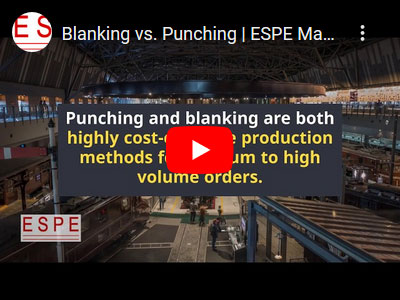Is There a Difference Between Blanking & Punching?
Leave a CommentAt ESPE Manufacturing Co., Inc., we provide a wide range of high quality stamping services for a broad spectrum of materials, including nylon, vulcanized fibre, and neoprene. Our robust, quality-driven stamping capabilities include:
- Forming: This process utilizes forces such as compression, shear, and tension to deform and ultimately transform materials into desired shapes or forms.
- Scoring: Scoring employs a machine tool to cut a groove into the substrate. The groove is then utilized to facilitate other processes, such as acting as a breakage point, decorative flourish, or guideline for a finishing operation.
- Impression stamping
- Blanking
- Punching
The similarities between the two latter processes often lead many to wonder: “Is there a difference between blanking and punching non-metals?” The following information will answer that question.
Blanking vs. Punching
Both blanking and punching are material forming processes that involve the precise removal of material from a workpiece. The main difference between the two processes lies in the end product produced.
In blanking operations, the final part or product is removed or “punched-out” out of the larger sheet material, with the remaining material being discarded as scrap. On the other hand, in punching operations, the material removed is discarded, and the final product is the remaining material which then undergoes further processing.
Delineating between blanking and punching is analogous to the following:
- If you punch a hole out of a piece of paper and keep the circular piece, then you have blanked the paper.
- If you keep the sheet of paper and throw away the punched-out piece, then you have punched the paper.
Another difference between the two processes is how manufacturers approach processing the initial sheet material. In a punching operation, they typically remove the smallest amount of material necessary from the original workpiece to minimize material waste. In contrast, blanking operations are most efficient when the maximum amount of material is removed from the workpiece.
Punching and blanking are both highly cost-effective production methods for medium to high volume orders. While the punched out slug in a punching process may not be part of further operations, in many cases it can be recycled or otherwise reused, resulting in significant cost savings.
Which Blanking and Punching Materials for Manufacturing Do We Provide?
At ESPE, we use several materials in our blanking and punching operations. The three primary materials that we work with are:
- Formex:This is a highly versatile, flame-retardant electrical insulating material.
- Nomex: This material’s meta-aramid polymers provide excellent electrical insulation, as well as chemical, thermal, and radiation resistance. Nomex also offers enhanced strength and durability.
- Vulcanized Fibre/Fishpaper: Electrical grade vulcanized fibre, or fishpaper, has many unique properties, including a lightweight design, ease of forming and punching, and resistance to heat or cold. ESPE’s fishpaper is comparable to other brands of vulcanized fibre, such as NVF’s Forbon brand, or Spaulding Composites’ Armite brand.
Partnering with Blanking and Punching Experts
While at first glance, blanking and punching may seem like identical processes, there are subtle but significant differences between the two, both in intent and in operation.
As an industry leader in electrical insulation materials and fabricated plastic parts, ESPE Manufacturing Co., Inc. has the experience and expertise to provide both blanking and punching services to each of our customers. Family owned and operated since 1948, ESPE is here to serve all of your fabrication needs. Our commitment to providing excellent service and delivering premium products has made us the top choice for many companies in need of customized non-metallic parts.
If you’d like to learn more, contact us, or request a quote today.

